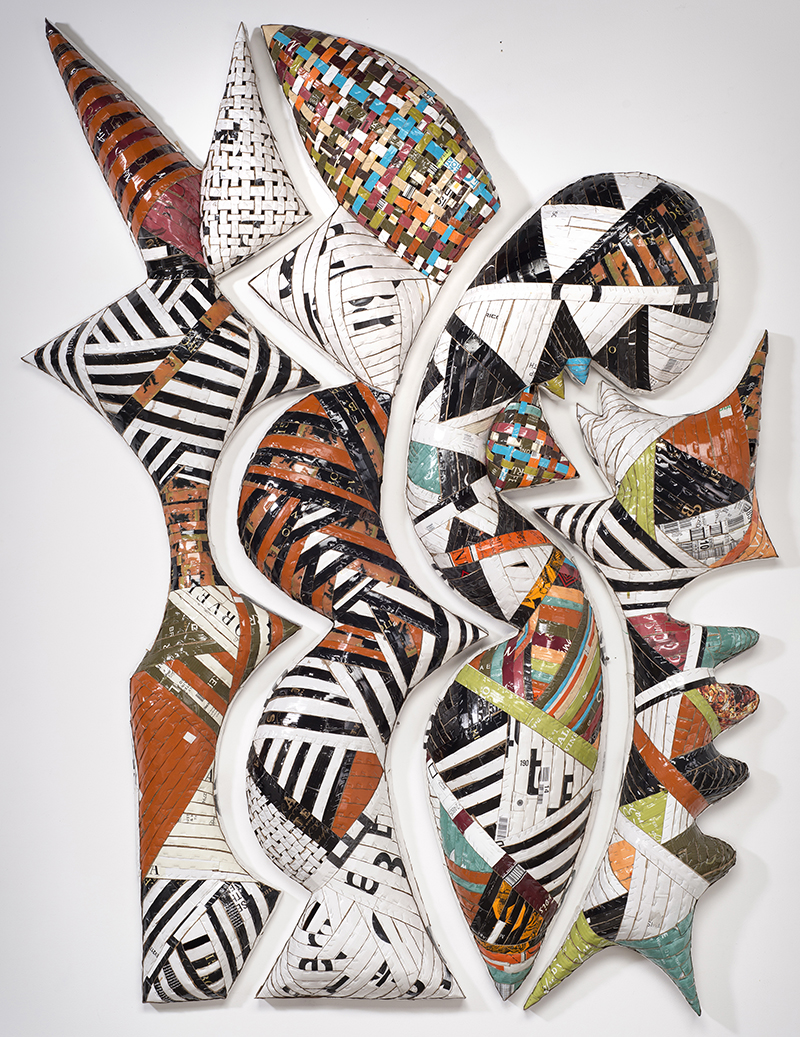When Ann Weber began working on her current series of monumental sculptures made from recycled cardboard, vitriolic rhetoric about constructing a border wall dominated the news. Trying to grapple with the idea, her research led her in a surprising direction, to Pink Floyd’s 1979 rock concept album which addresses fear and domination, The Wall. A song about abusive schoolmasters appears on the album, and Weber adopted its title, “Happiest Days of Our Lives,” for her recent exhibition at Dolby Chadwick Gallery.
Weber presented large scale freestanding and wall-mounted works created by using her unique technique of bending, twisting, weaving and stapling thick strips of cardboard. The artist mines alleys and trash heaps for interesting boxes, and has taken her dumpster-diving routine on the road to locations such as Rome and Beijing, where she has held artist residencies. Weber draws ideas from the architecture and scenery of the San Pedro area where she now lives. The area has recently provided inspiration for murals and walls covered by the ornate shapes of Gothic-style gang graffiti.
Gothic on Grand (Stick ‘Em Up) (2019) features a pair of sculptures standing about human height, the voluptuous forms of one countered by the angular forms of its more monochromatic partner. Weber always begins with a 2D shape, using the corresponding negative shape to construct the following work, so connections and intersections are a logical result. Weber’s work, with its woven, hand-made quality, springs from the foundation of craft, yet also inhabits the realm of formalism, Brâncusi’s spare modernist sculptures come to mind. The grid pattern created by the voids also speaks the language of Minimalism.
In the wall-mounted work, Weber expands this pairing into a multiplicity of connections, suggesting bonds to heal, rather than barriers to fracture. Happiest Days of Our Lives #22-27 features flowing, organic shapes, negative spaces of oval and teardrop shapes, flanked with spikier, more assertive forms ending in conical protrusions. Letters and fragments of text emerge. In HDOOL #18-21, Weber emphasizes color, stripes of brick orange, pumpkin, and turquoise, along with green gold, creating a joyous, heterogeneous, vibe.
Personages Poetry (2016), a pair cast in bronze, dominates the back room. With an economy of means, Weber suggests the tenderness and fallibility of human relationships, the bronze casting lending the work an element of greater gravitas. Still, the cardboard works retain the endearing marks of the human hand and glow with a warm patina of sun-baked cartons. Weber’s mastery of her unusual medium is so complete that each piece conveys a sense of irrefutable logic, that somehow it was destined to emerge in just this way. Her work reflects a belief in the power of the spirit to overcome adversity and divisiveness, and her enduring optimism is infectious.



